�
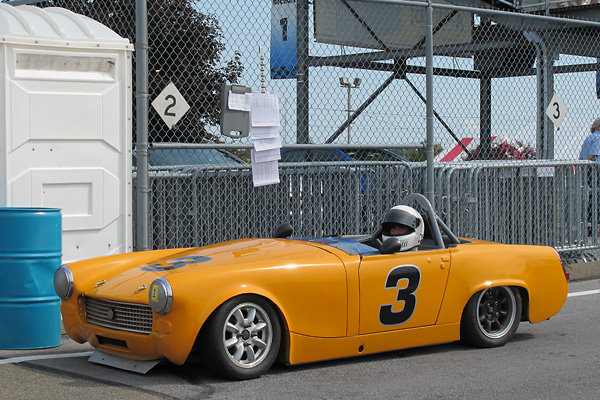
�
Rick Haynes' 1965 MG Midget Vintage Racecar
� ��
Owner: Rick Haynes
�
City: Hebron, Ohio
�
Model: 1965 MG Midget
�
Engine: BMC A-Series 1275cc
�
Prepared by: owner�
�
BritishRacecar Interviews Rick Haynes
��
Q: Rick, how long have you owned your MG Midget?
�
A: The orange one here? I built it... two years ago. (~2010)�
�
Q: Was it a racecar at all when you started?
�
A: No, it was a bare tub that I found in a garage in Gettysburg PA.�
�
Q: And this racecar was never meant for SCCA; it's strictly a "vintage" car?
�
A: Yes. It was built so I'd have something to do now that SCCA has lost interest in all the older cars.�
�
Q: It's probably about as low as anyone gets a vintage car?
�
A: Well, that's one of the things you want to do with a racecar... one of the primary things to accomplish.�
�
Q: So one of the first things to do was route the exhaust through the tunnel. Did you make your own headers?
�
A: I do everything on these cars except the heads. The heads are done by George Bachmann of Midwest Motorsports�
in Toledo. I fabricate headers, build carburetors, build the motors, design all the pieces... that's sort of�
what I do in my business. �
�
Q: What other parts should I point out to people?
�
A: Well, I build all the important parts to build a Midget because I like the quality of my own stuff better�
than what I can buy. So, I make the hubs and the axles - the front hubs and the double-bearing rear hubs - the�
exhaust systems, the carburetors, the camshafts, the pistons, basically all the essential pieces.�
�
�
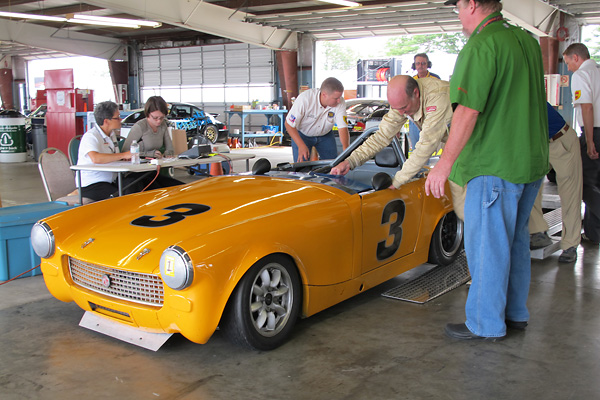
�
Coming off the scales after winning his race. 1275cc Spridgets are required to weigh at least 1470#,
�
plus 20# if "no headlights", plus 25# if "no charging system", plus 20# if "removal of passenger seat".
�
�
Q: And the suspension geometry is special?
�
A: Probably not special in the respect that it certainly isn't anything but fairly traditional stuff, but�
it's got stuff in it that I've found during the years worked pretty good, but it's probably not that much�
different than other peoples'. There's only certain perimeters that you can do in a suspension, and�
everyone has got to pretty much adhere to that.�
�
Q: On an MGB, I know people are doing dropped spindles to raise the roll centers. It that a similar game�
on a Spridget?
�
A: Anytime you drop a car down, you've got to take into account what you've done to the roll centers and�
you've got to make the adjustments accordingly.�
�
Q: Are those steel fenders? They have to be for vintage don't they?
�
A: Yes. The rules say "no flares" and everything has to be steel, but with the economics of running a race�
they're more interested in the entry fee than they are with adhering to the rules, and they're getting pretty�
flexible with that stuff, and I noticed in the five or six years prior to building the car myself - just�
going to the vintage races - it was pretty clear that they had sort of become very flexible in that area�
so I built it with a little bit of a flare front and rear just to keep up with everybody else.�
�
Q: So the flare... this part is glass?
�
A: No. Everything you can feel with your hand (underneath) is steel. There's just a little bit of Bondo to�
contour it out. But everything you can feel is steel. Same at the back.�
�
Q: And the chin spoiler? That's to the vintage rules?
�
A: Well, you know, I kept expecting someone to say something about that. The way I understand the rules is�
that anything that was legal prior to 1972 is legal, and I've got photos and documentation that shows they�
were running spoilers prior to that. I'm just sort of waiting for somebody to come up and say I can't run�
it. I haven't needed to pull out all my stuff yet!�
�
Q: The windscreen is about as low as it could possibly be.
�
A: Yes. I try to sit as low in the car as I can, and there's no reason...�
�
Q: You're wearing a visor anyway.
�
A: That's right. I just put a little thing to deflect the air a little bit.�
�
 �
�
�
�
�
Q: You're not allowed to run a dry sump?
�
A: That's right. I run an Accusump, and an oil pan of my own design.�
�
Q: Is there anything from Winners Circle or Huffaker on the car?
�
A: Oh God no! I wouldn't put a Winners Circle or Huffaker made part on my car. I think all the parts I�
have are better than theirs. And I have no reason to... you know. I've been doing this long enough that�
I know what all the faults and all the advantages are, so I build them or I have them built to my own�
specifications. Well... the one thing that might be considered a Huffaker part is the seat in this car.�
It came out of the Jon Woodner Midget that he totaled in Atlanta at the 1971 runoffs.¹ He stuck it in a�
barrier. Sold the car to Bill Koch in 1972, and I bought the seat off of him. I've used that seat in a lot�
of cars.�
�
Q: Tell me about the rear.
�
A: Well, that's pretty traditional. They've been using three link slipper rears - or slipper rears with�
one design or another - way back into the sixties with Trans Am cars. Oh, what's his name. Bud Moore.�
Bud Moore did slipper rear ends for the Mustangs and Cougers. It's an adaptation so that you can use a�
leaf spring without any of the disadvantages. It's fairly complicated to build, but once you get it right�
it's almost as good as a coilover. Not quite, but almost as good as a coilover. Huffaker did them for�
their cars. In fact, it's probably designed pretty close to what Huffaker put in the Midgets and it's�
probably pretty close to what Joe put in his Midget because it's a fairly traditional design that everyone�
knows about.�
�
Q: Watts link for side-to-side?
�
A: Yes, Watts link plus single link in the top and two lower links on either side below the springs.�
�
Q: And the springs are gullwing springs? Do you need that on a vintage car?
�
A: I wasn't sure if you did or not, but since I knew the specification of the gullwing springs and I�
had to do something anyway I decided to do them that way.�
�
�
IMPORTANT ANNOUNCEMENT
�
BritishRaceCar.com will have to cut back plans for continued growth if we can't find more financial support.
�
If you like what you've found here, and you want to see more, please click here and follow the instructions.
�
Readers like you keep BritishRaceCar.com online and growing through voluntary financial contributions.
�
�
Q: How do you make a gullwing spring? Do you cut a wider spring?
�
A: Yeah, you take a 3" piece of spring steel and you cut it out. And then you take it to the spring�
shop and have the ends rolled on it, have it tempered and arched, and you hope you got it right.�
�
Q: And the differential. Is it welded?
�
A: Yes, it's a welded "4.2".�
�
Q: Do you change the ratio for different tracks?
�
A: For the most part, the 4.2 seems to be good everywhere. If I went to Road America I might consider�
putting a 3.9 in it. Plus it's complicated. You might have to change your gearbox ratios, and that's�
more trouble than its worth.�
�
Q: I didn't see which shocks you run...
�
A: You can run tube shocks in the back, but you have to keep lever shocks in the front. They're�
Armstrong lever shocks in the front and then tube shocks in the back.�
�
Q: In the front, are those Peter Caldwell (World Wide Imports, modified) adjustable shocks?
�
A: No, they're something I did myself.�
�
Q: And the gearbox?
�
A: A gearbox I built. It's basically a copy of what everyone else runs. It uses Mk9 Webster (Hewland)�
gears. When Todd Wheeler started making them in the early eighties they were sort of a unique thing.�
Then Todd stopped making them for whatever reason. I needed a couple of gearboxes, so I started building�
them myself. All the pieces in them were made by Webster. Unfortunately, Webster is out of business,�
so you can't do that anymore. And the gearbox is basically a re-engineered gearbox of what Wheeler did.�
Richmond took apart a Wheeler box and he built an improved version of the box with a lot of high-buck�
stuff. Then when Richmond stopped, Taylor took a Richmond box and basically copied that. Of all the�
copies out there, in fact, the Richmond and Taylor are closest to identical. I think they have a lot�
of parts that swap out. But I don't like to pay people money for stuff I can do myself and I can build�
a gearbox as well as anybody else. This gearbox is twenty years old.�
�
Q: What else should I know about?
�
A: The orange is the same color as my first SCCA car. Except, the orange I had then was Rust-Oleum�
"Omaha Orange" out of a spray can and this one is '70 Mustang "Grabber Orange". This is what the�
Trans Am color is. Actually, they say this is what the color was in 1970, but I think it's a little�
brighter. It's what Ford used about five years ago on their Boss 302.²�
�
Please support the sponsoring companies who make www.BritishRaceCar.com possible, including:
� �
 �
�
�
�
Features and Specifications
�| Engine: | �1275cc BMC A-Series engine with 0.020" overbore. �
Billet crankshaft.�
Venolia forged pistons. �
Carillo connecting rods.�
Sports & Imports camshaft.�
Midwest Motorsports modified cylinder head.�
Titan roller rockers (1.5:1 ratio.)�
Iskendarian lifters, valve springs and retainers.�
Iskenderian chrome-moly tubular pushrods (8.437" long, part# SP-003).�
Sports & Imports modified dual S.U. HS4 (1.5") carburetors.�
�
Mallory Unilite distributor.�
Jeg's 8mm Power Wire spark plug wires.�
NGK spark plugs.�
MSD Blaster 2 ignition coil.�
MSD 6AL capacitive discharge ignition box (part# 6420).�
Modified Datsun 240Z gear reduction starter.�
Sports & Imports wet sump oil pan (external pickup plumbing).�
Accusump oil accumulator, with electric solenoid valve.�
Fram Racing HP11 engine oil filter, remotely mounted. | �
| Cooling: | �Sports & Imports copper and brass crossflow radiator.�
Custom fabricated aluminum header tank.�
Modified water pump.�
Oil cooler. | �
| Exhaust: | �Sports & Imports long-center-branch 3-into-1 header. �
Through-the-tunnel exhaust system.�
Sports & Imports megaphone style exhaust tip. | �
| Transmission: | �Sports & Imports rib-case 4-speed dog-ring gearbox.�
Lightweight flywheel. �
Tilton 7.25" single disc clutch.�
Girling 0.625" master cylinder. | �
| Rear Axle: | �straightened Spridget axle housing.�
Sports & Imports two piece competition axle shafts.�
Sports & Imports double bearing hubs.�
Welded differential.�
4.2:1 ring and pinion. | �
| Front Susp.: | �Sports & Imports aluminum front hubs.�
? coil springs.�
Modified Armstrong lever shock absorbers.�
Sports & Imports modified lower control arms and kingpins.�
Steering arms modified to reduce bump steer. �
3/4" tubular anti-sway bar, mounted on aluminum pillow blocks. | �
| Rear Susp.: | �Sports & Imports prepared "slipper" three link.�
(Axle is located by one radius rod above the pinion and two below the leafsprings.)�
Gullwing semi-elliptic leaf springs.�
Carrera telescoping shock absorbers.�
Adjustable anti-sway bar.�
Watts linkage (with pivot mounted on chassis). | �
| Brakes: | �(master) Sports & Imports modified pedal assembly. Dual master cylinders�
(Wilwood 0.625" front, Girling 0.700" rear.) Allstar Performance remote bias adjuster. � (front) stock 8.3" rotors and calipers. Hawk "blue" brake pads. � (rear) stock 7" drum brakes. | �
| Wheels/Tires: | �Panasport Racing 13x6 aluminum wheels (front).�
Western 13x6 aluminum wheels (rear).�
Hoosier Street T.D. *S P185/60D13 racing tires. | �
| Instruments: | �(left to right) �
Jones / Moroso mechanical tachometer (1000-11,000rpm),�
AutoMeter Sport-Comp oil pressure gauge (0-100 psi),�
Westech dual pyrometer (700-1700F),�
Stewart Warner oil temperature (140-325F),�
AutoMeter fuel pressure (0-15psi), and�
AutoMeter Sport-Comp coolant temperature (120-240F) guages. | �
| Fuel System: | �Jaz Products Pro Sport fuel cell with D-ring cap.�
Dual Facet (Bendix style) fuel pumps.�
Fram HPG1 fuel filter.�
| �
| Safety Eqpmt: | �Sports & Imports rollcage.�
G-Force Racing Products Pro Series 5-point cam-lock safety harness (with Pyrotech pads). �
Low-back fiberglass racing seat.�
Lecarra steering wheel mounted on a quick release hub.�
Vitaloni "Sebring" mirrors.�
Phoenix Halon fire suppression system.�
Attwood Sea Guard marine battery box.�
�
Pollak battery disconnect switch. | �
| Racing Class: | �SVRA Group 1, F-Production | �
Engine Installation
��
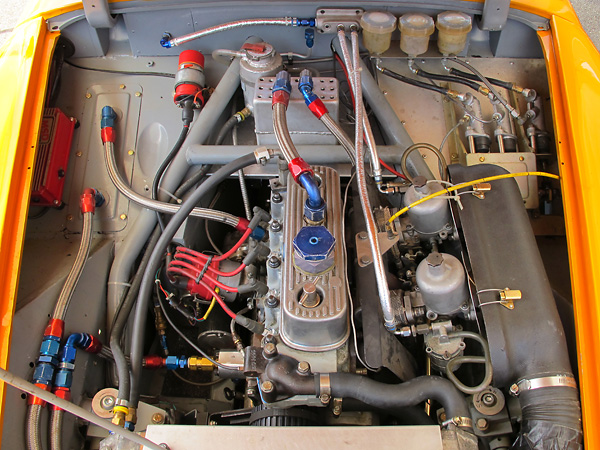
�
1275cc BMC A-Series engine with 0.020" overbore.
�
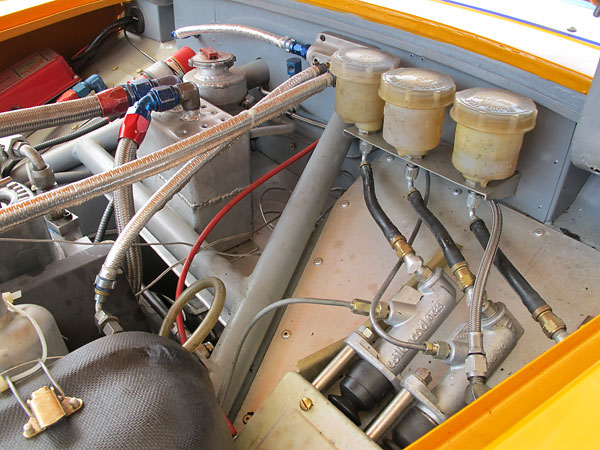
�
The remote reservoirs are marked: "Use Only Castrol Girling Fluid".
�
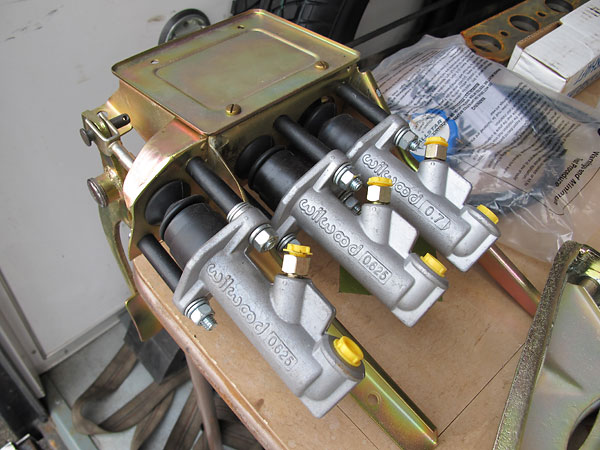
�
Sports & Imports modified Spridget pedal assembly.
�
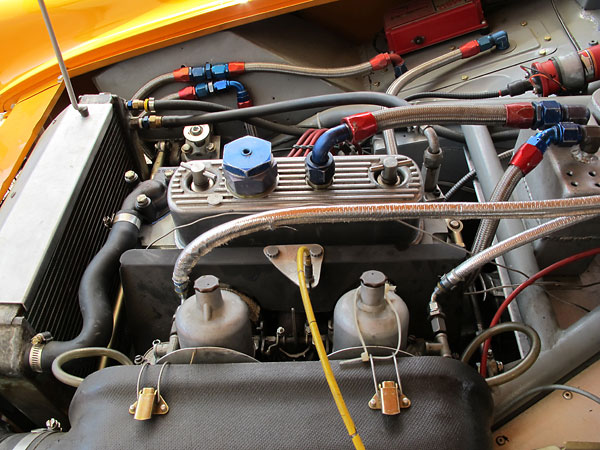
�
George Bachmann at Midwest Motorsports ports Rick's cylinder heads.
�
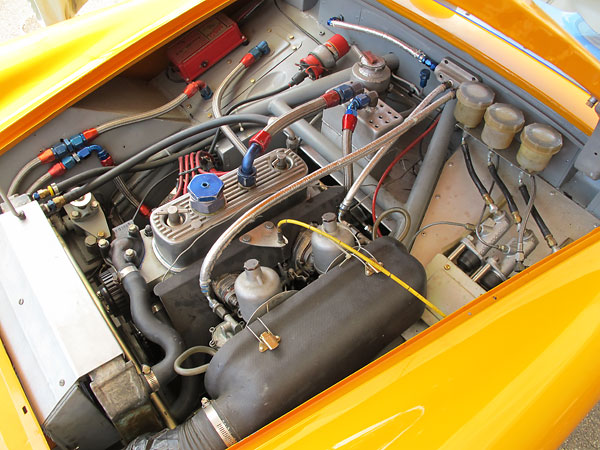
�
Engines run better and make more power from cooler air.
�
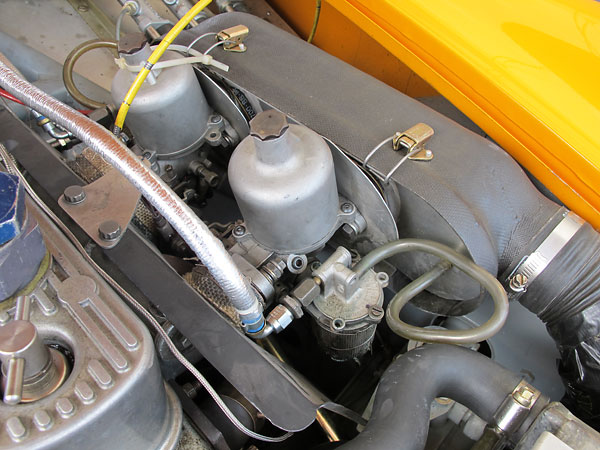
�
Sports & Imports modified dual S.U. HS4 (1.5") carburetors.
�
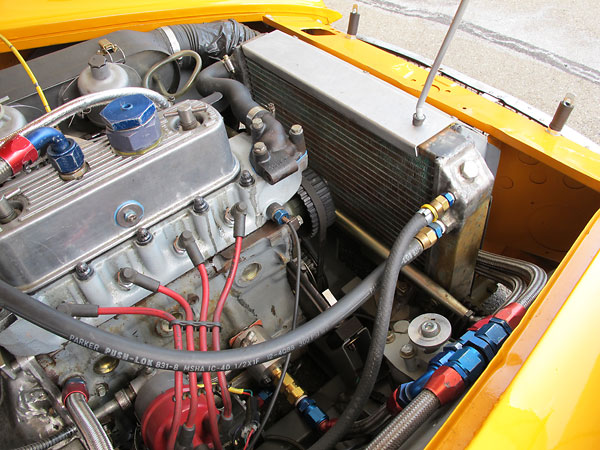
�
Sports & Imports copper and brass crossflow radiator.
�
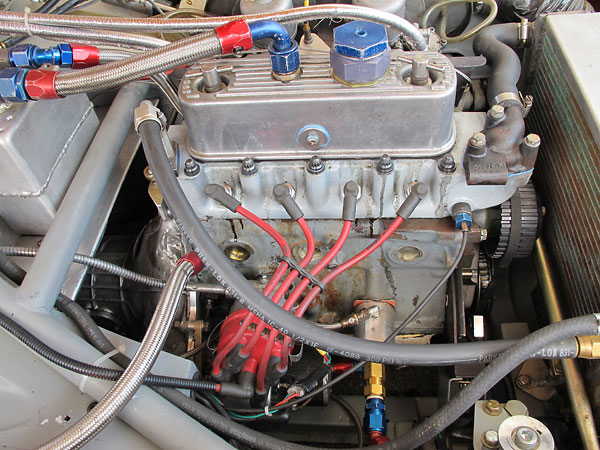
�
Mallory Unilite distributor and Jeg's 8mm Power Wire spark plug wires.
�
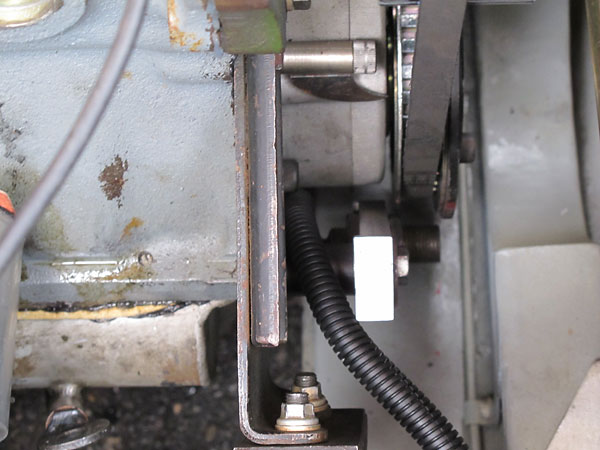
�
Top of frame: a nifty pointer to aim your dial-back timing light at. Center: a Hall effect
�
sensor has been positioned to detect crankshaft speed, but apparently it senses just one
�
tooth once per revolution. (In this view, we can't see any teeth on the trigger wheel.)
�
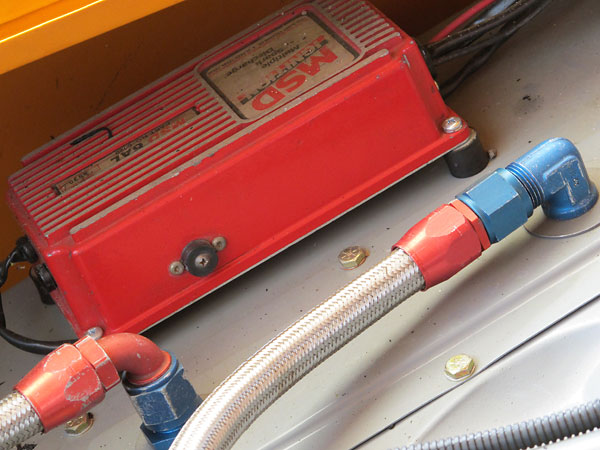
�
MSD (Multiple Spark Discharge) model 6AL ignition box. Note: the 6AL
�
model includes a rev-limiter, but Rick doesn't use that feature.
�
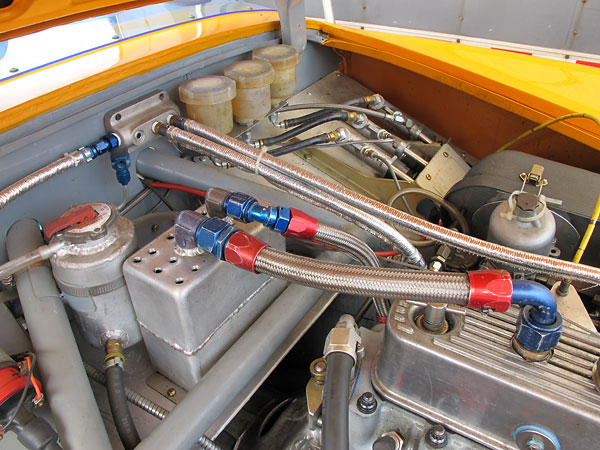
�
Custom fabricated aluminum coolant header and crankcase breather tanks.
�
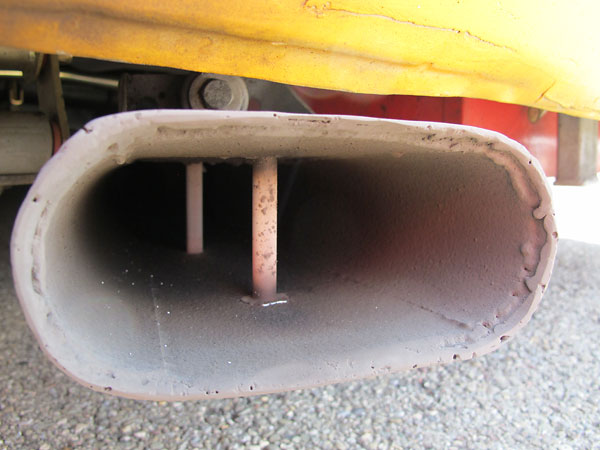
�
Megaphone style exhaust tip.
�
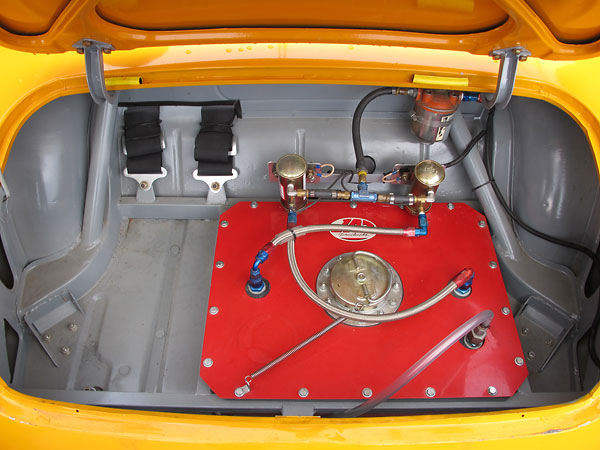
�
Jaz Products Pro Sport fuel cell with D-ring cap and breather.
�
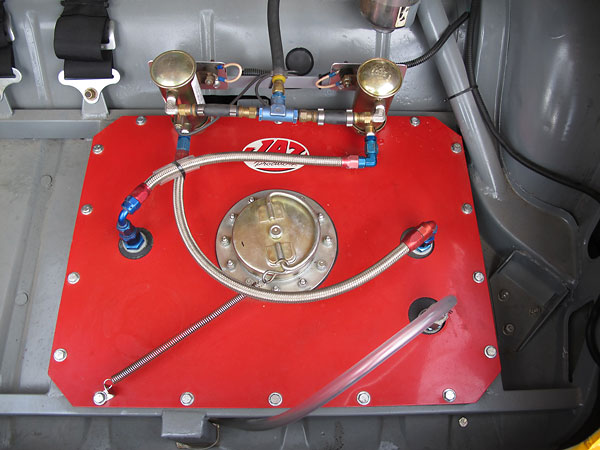
�
Dual Facet (Bendix style) fuel pumps. Fram HPG1 fuel filter.
�
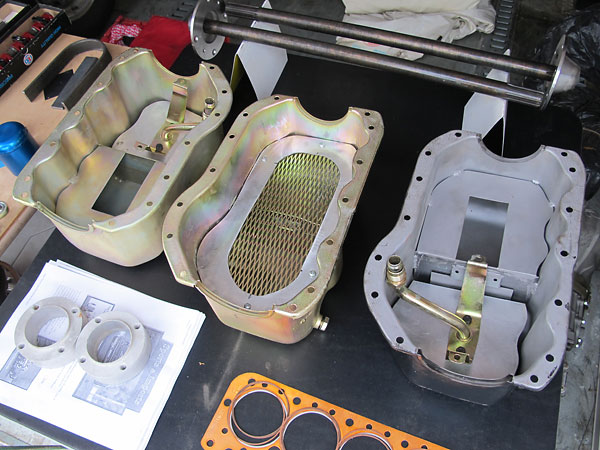
�
Two styles of Sports & Imports wet sump oil pans. The pan in the center
�
(with external pickup port) is similar to what Rick uses on his own car.
�
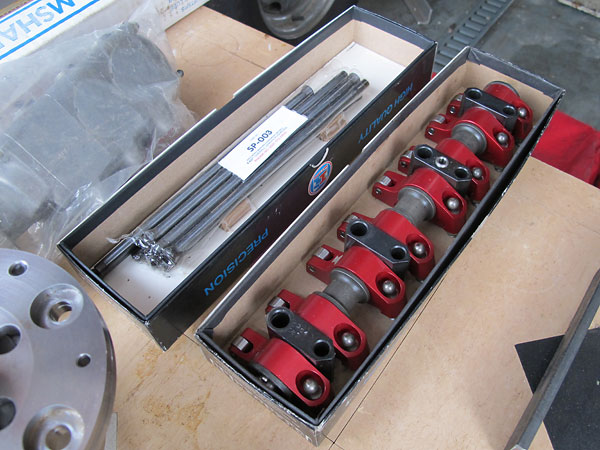
�
Titan roller rockers (1.5:1 ratio.) Isky chrome-moly tubular pushrods (8.437" long, part# SP-003).
�
�
Front Suspension / Etc.
��
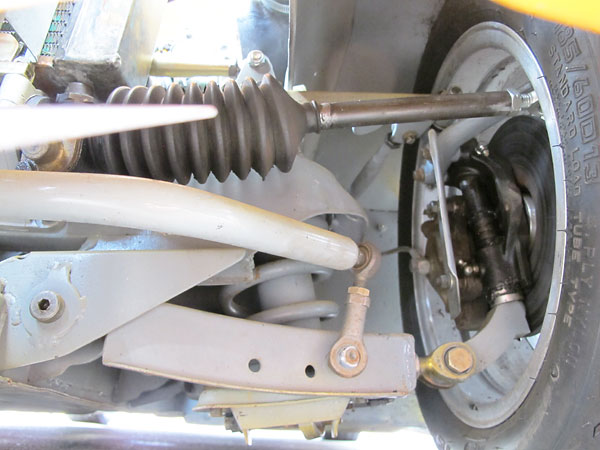
�
Modified upper and lower control arms. Normally, a Spridget's upper control arm is a single link
�
that's integral to the lever shock absorber. Here, a supplemental link extends rearward.
�
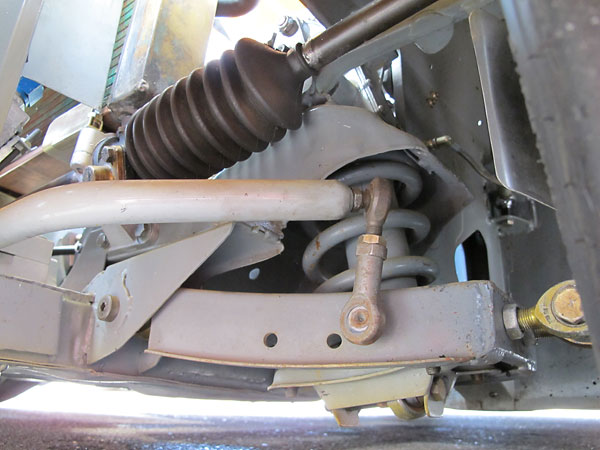
�
A theoretical advantage of lever shock absorbers over telescoping shocks is they don't add
�
unsprung weight. In practice, most racers prefer tuning telescoping shocks.
�
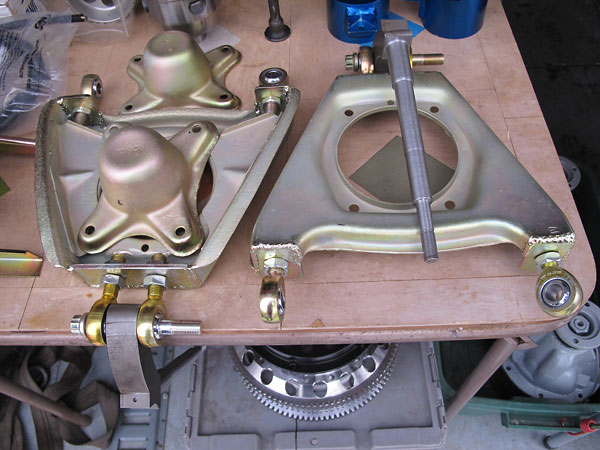
�
Billet steel kingpins.
�
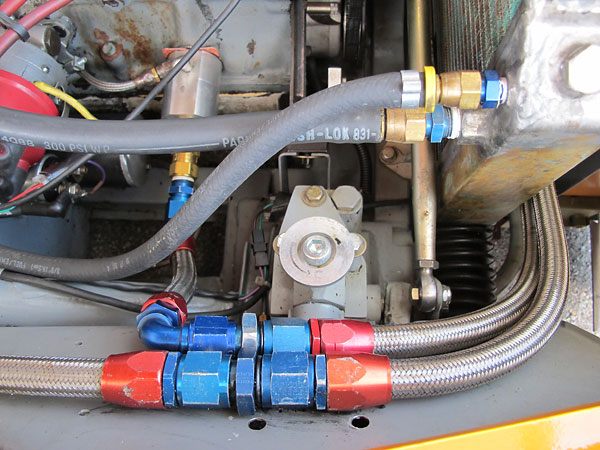
�
A swaged Monte Carlo bar stiffens the front suspension mounting areas.
�
�
Profiting from this article? Not us! Please help us cover travel and web hosting expenses.
�
To toss some change in our tip jar, please click here. Doing your part is quick and easy.
�
We also offer targeted, cost effective advertising options. Please click here to learn more.�
Rear Suspension
��
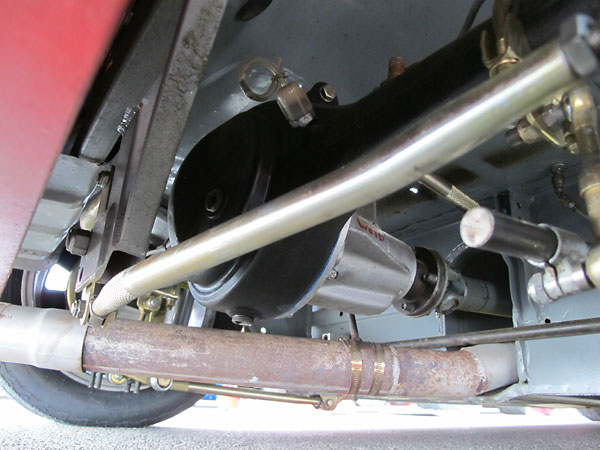
�
Straightened axle housing for a welded differential and 4.2:1 gears.
�
A Watts linkage keeps the axle centered, relative to the body.
�
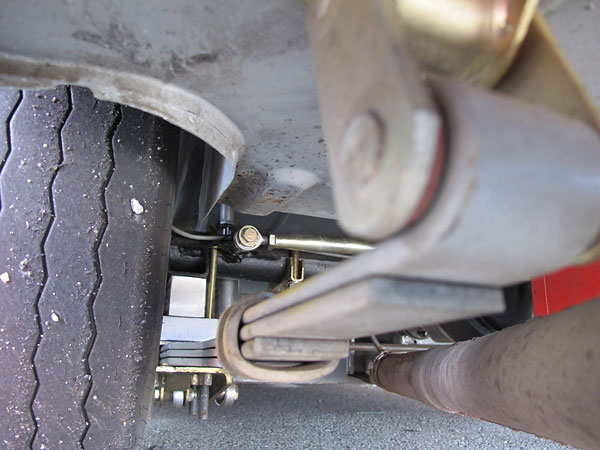
�
Gullwing springs were developed to provide clearance for the very wide
�
racing slick tires used on MG Midget racecars in the 1970s.
�
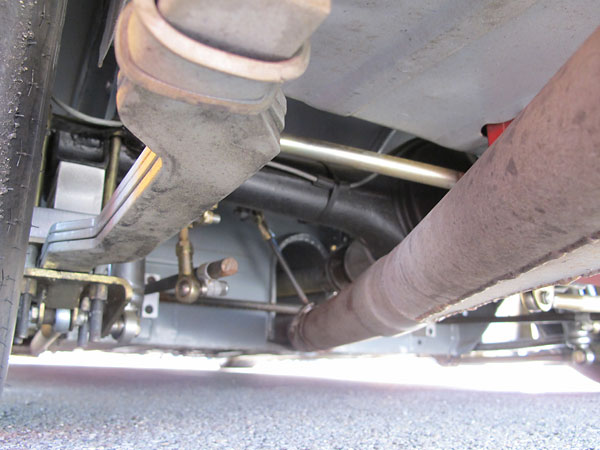
�
This is a slipper style three-link rear suspension: spacers prevent the U-bolts from
�
clamping to the leafsprings, so the springs only locate the axle in one axis. Three
�
radius rods (two under the springs and one centered, above the driveshaft) locate the axle.
�
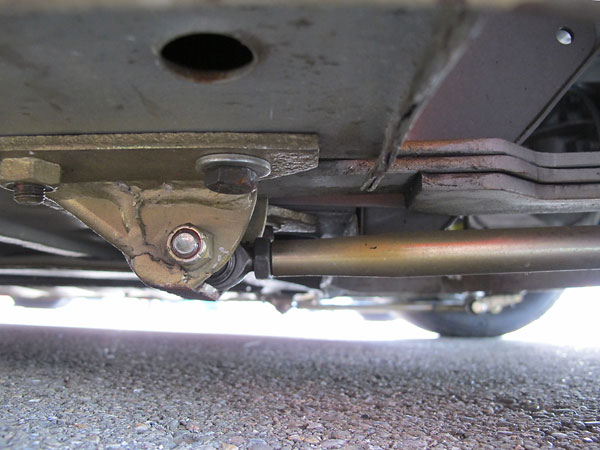
�
This is one of the radius rod mounting brackets.
�
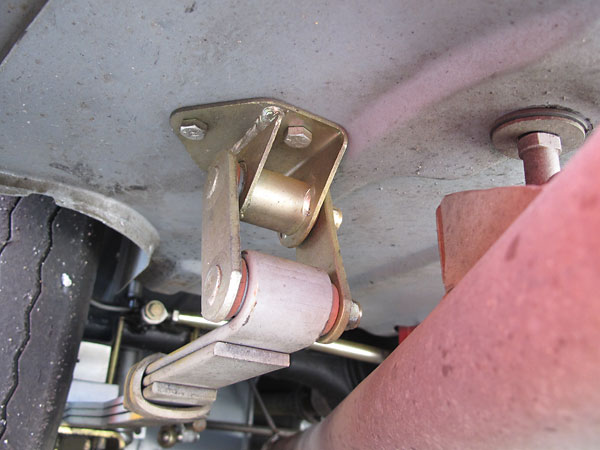
�
Spring shackle.
�
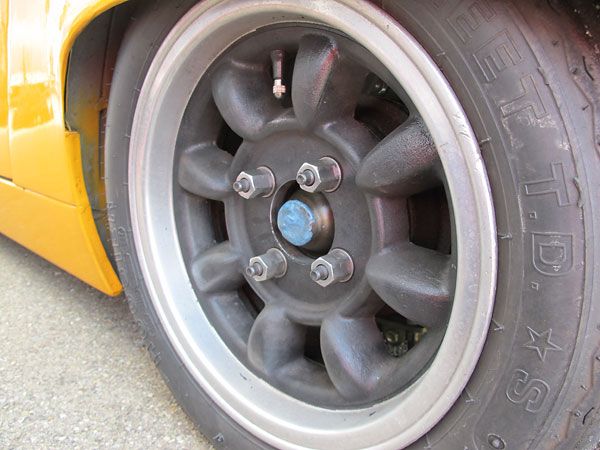
�
Rick is using two-piece axles. The axle shaft and the hub are connected by splines.
�
Blue sealant helps deter axle lube from seeping through the splined joint.
�
�
Interior
��
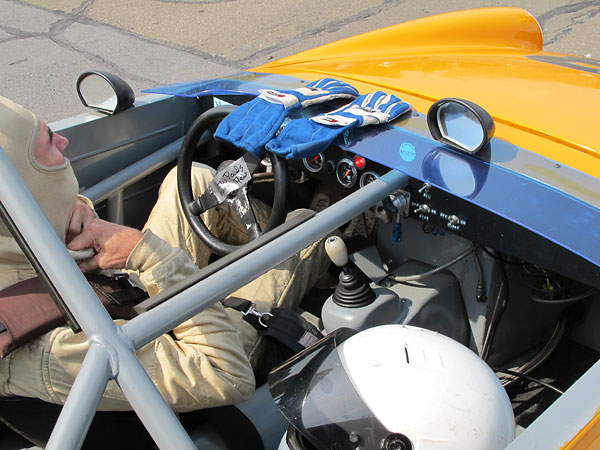
�
Vitaloni Sebring mirrors. Toggle switches are labeled "Oil", "Dist", and "Crank".
�
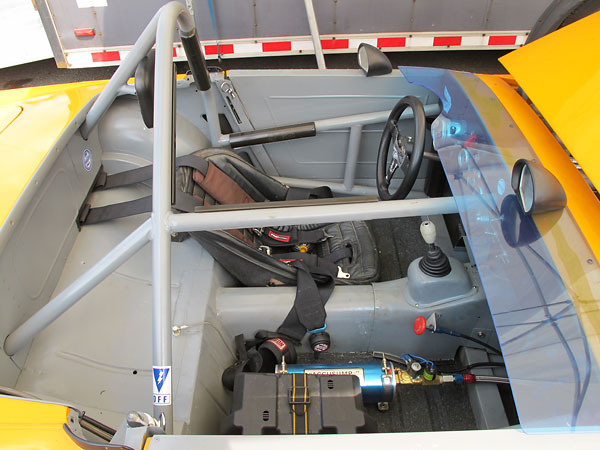
�
This very same fiberglass bucket seat was used by Jon Woodner at the 1971 SCCA Runoffs.
�
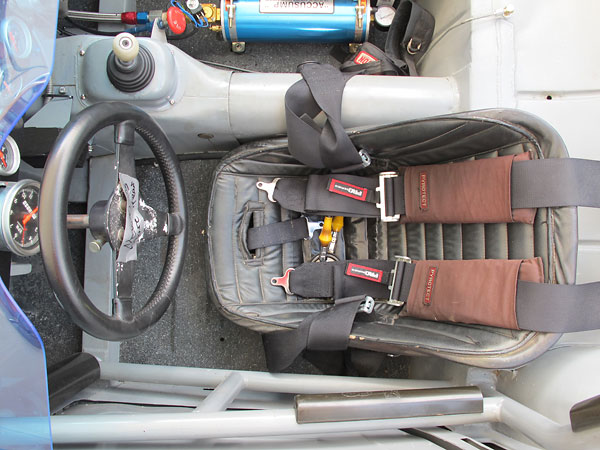
�
Lecarra steering wheel mounted on a quick release hub. G-Force 5-point harness (w/ Pyrotech pads).
�
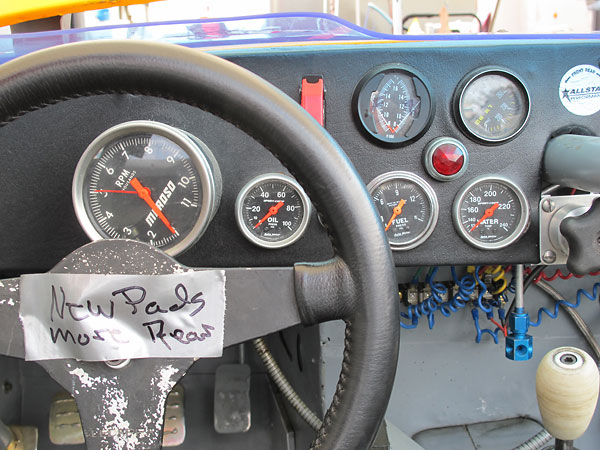
�
Jones / Moroso mechanical tachometer, AutoMeter Sport-Comp oil pressure gauge, Westech
�
dual pyrometer, Stewart Warner oil temperature gauge, low oil pressure light, AutoMeter
�
fuel pressure gauge, and AutoMeter Sport-Comp coolant temperature gauge.
�
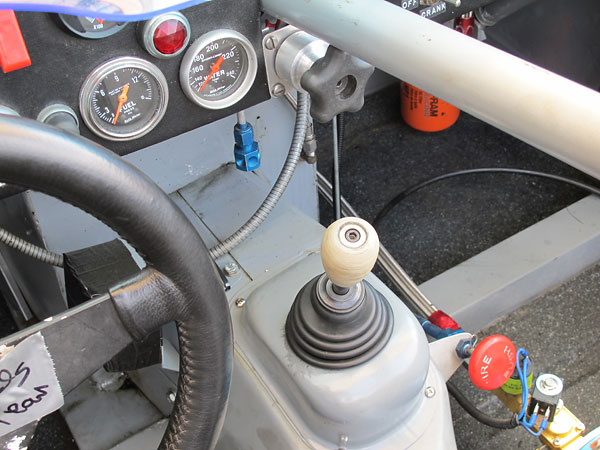
�
Allstar Performance remote brake bias adjuster knob.
�
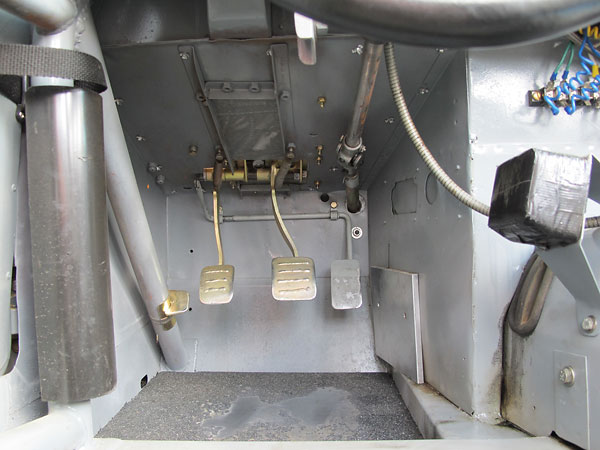
�
What a nifty little dead pedal!
�
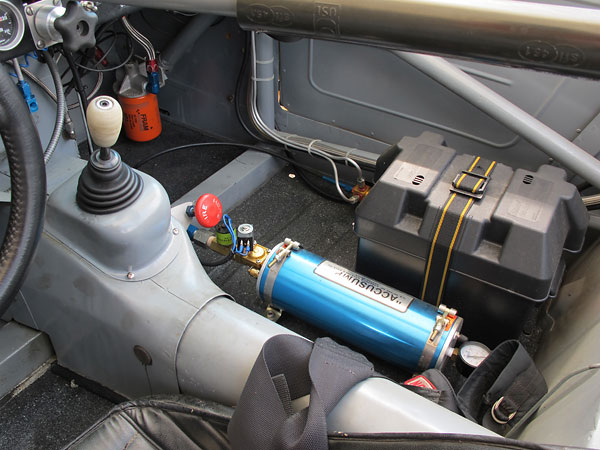
�
This Accusump oil accumulator is electrically actuated from a toggle switch on the dashboard.
�
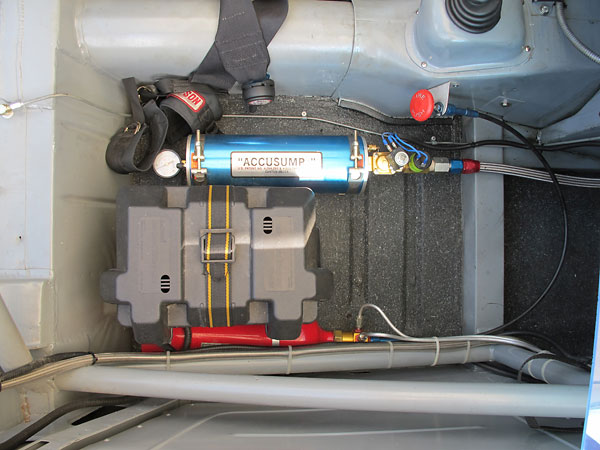
�
Attwood Sea Guard marine battery box. Phoenix Halon fire suppression system.
�
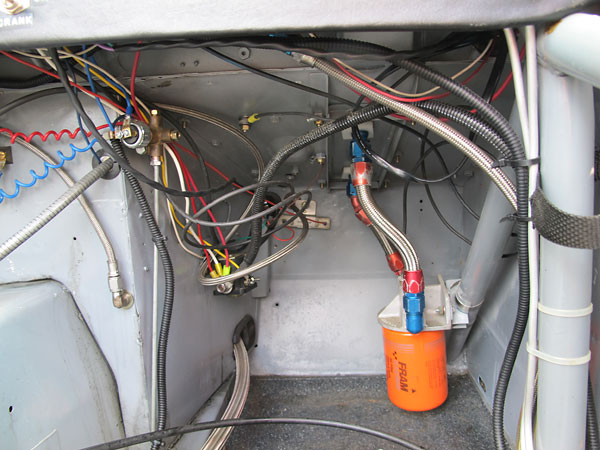
�
Fram Racing HP11 engine oil filter, remotely mounted.
�
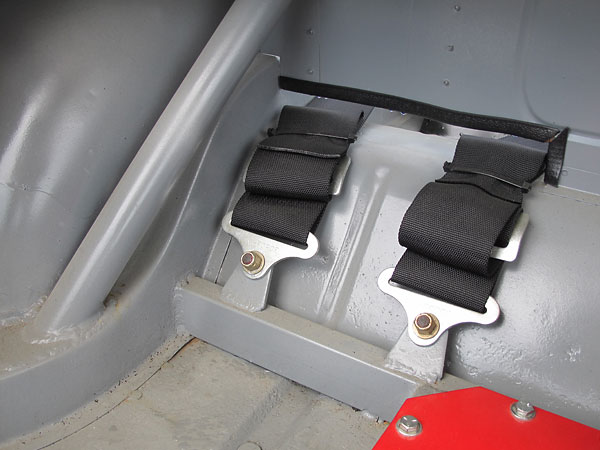
�
Shoulder harness attachment details.
�
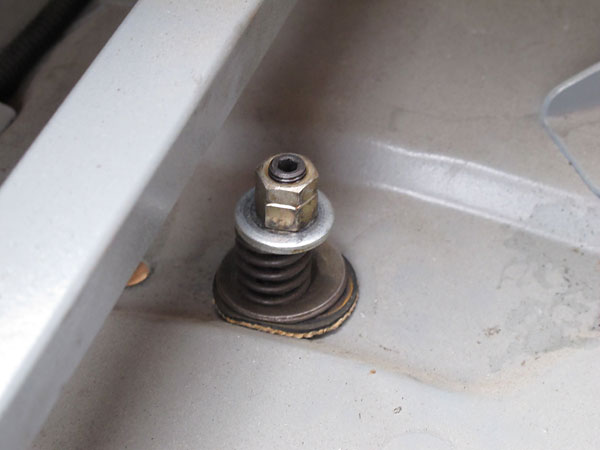
�
This is the spring mount at the rear of the trunk floor which supports the tailpipe.
�
�
Exterior
��
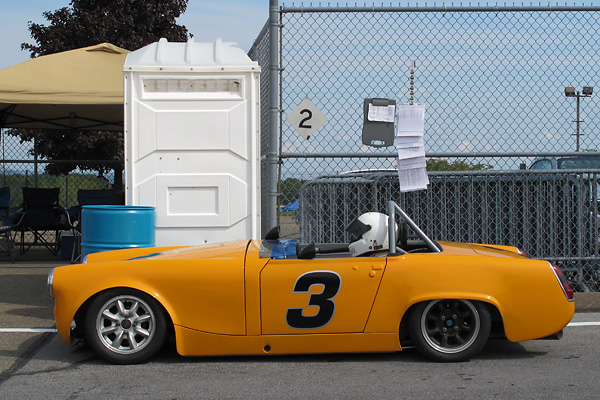
�
At the Sportscar Vintage Racing Association's 2012 US Vintage Grand Prix of Watkins Glen,
�
Rick Haynes circled the challenging 3.4 mile circuit with a very quick best lap time of
�
2:23.203 (85.473mph) to finish first overall in Saturday's Group 1 feature race.
�
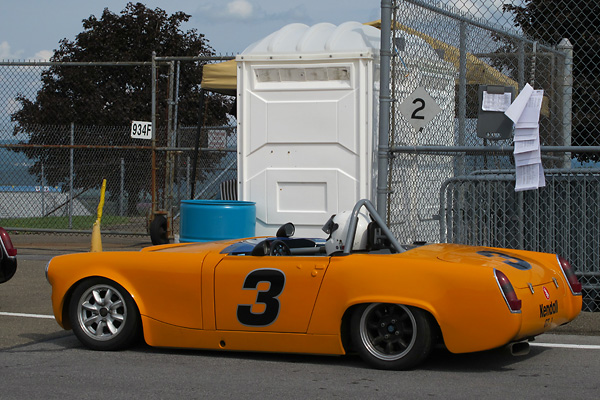
�
Rick Haynes won the 1985 SCCA National Championship (F-Production Class) in an MG Midget.
�
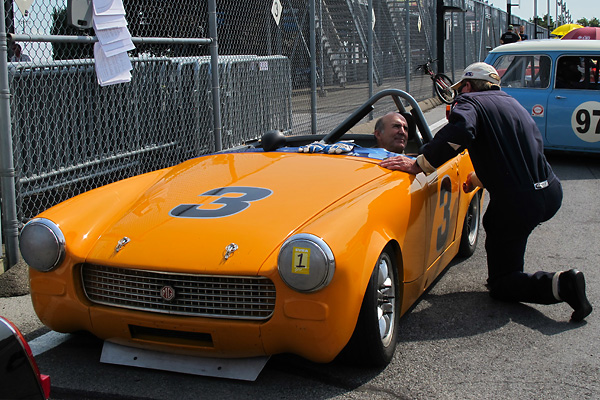
�
Fastest qualifier, Charlie Guest, comes back to shake hands with Rick before the race.
�
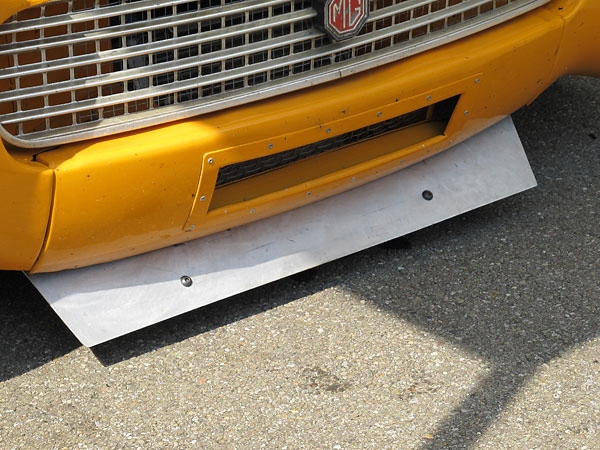
�
Authentic vintage-style aluminum MG Midget chin spoiler.
�
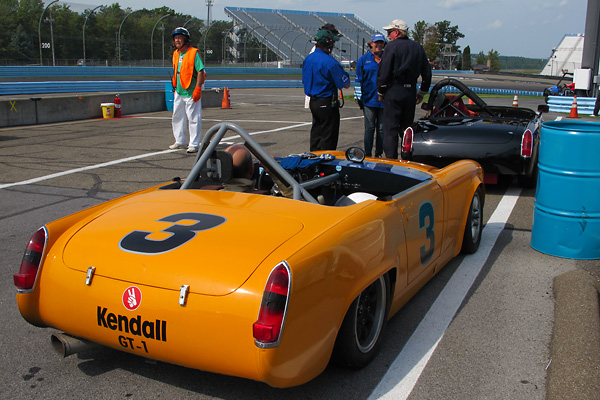
�
Flared fenders.
�
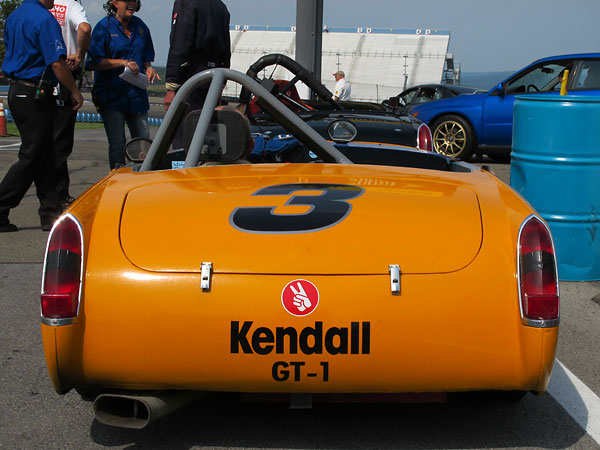
�
Kendall GT-1 livery. Late model Ford Mustang "Grabber Orange" paint.
�
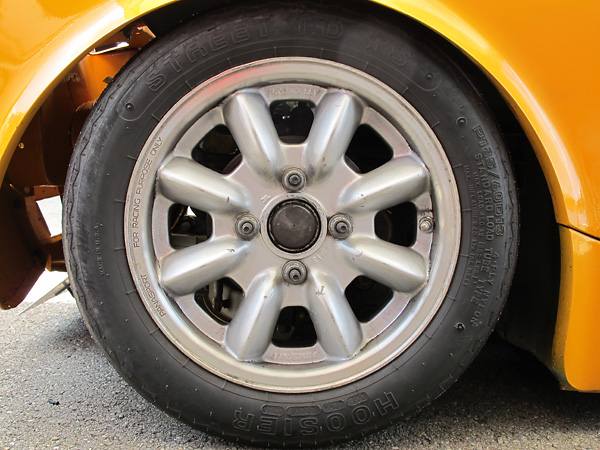
�
Front: Panasport Racing 13x6 aluminum wheels and Hoosier Street T.D. *S P185/60D13 racing tires.
�
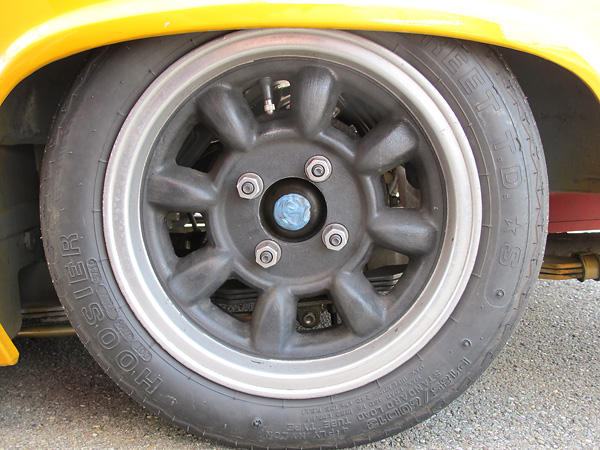
�
Rear: fake Minilite Sports eight-spoke wheels, probably made by Western.
�
�
Except where specifically noted above, all photos shown here are from September 2012�
when we viewed the car at Glenora Winery's Vintage Grand Prix of Watkins Glen, New York.�
Photos by Curtis Jacobson and Donnie Moyer for BritishRaceCar.com, copyright 2013. All rights reserved.
�
| Notes: | ||
| (1) | �
In 1971, Jonathan Woodner qualified seventeenth and then wrecked on the race's first lap.�
However, he returned to the SCCA National Championship Runoffs in 1972 to win the�
F-Production championship race from pole-position. Woodner was a keen rally driver�
and he piloted a variety of open wheel racecars too, progressing from Super Vees through�
a variety of Formula 5000 racecars (including a McRae GM1, a Talon MR1, and a Lola T332.) �
� | |
| (2) | �
Boss 302 Ford Mustangs which raced in the 1970 SCCA Trans Am series were actually�
painted Dodge's version of "School Bus Yellow". Bud Moore quickly and unhappily chose�
the color on a visit to a local paint retailer in response to a directive from Ford's�
public relations department. Their concern was that Moore's preferred red, black, and�
white paint scheme didn't show off cars well in black-and-white magazine photos.�
Dodge's School Bus Yellow is different from Ford's production "Grabber Orange". �
� | |
�
| If you liked this article, you'll probably also enjoy these: | �|||||
| Randy Byboth '64 Sprite | �
 | �
Derek Chima '66 MG Midget | �
 | �
John McCue '72 MG Midget | �
|
| You're invited to discuss anything you've seen here on The British Racecar Motorsports Forum! | �|||||
�
Notice: all the articles and almost all the photos on BritishRacecar.com are by Curtis Jacobson.
�
(Photos that aren't by Curtis are explicitly credited.) Reproduction without prior written permission is prohibited.
�
Contact us to purchase images or reproduction permission. Higher resolution images are optionally available.
�

 �
�